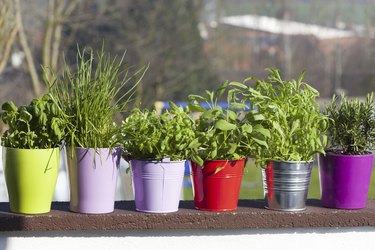
Herbs and spices add flavor and variety in cooking, but many insects don't appreciate their strong scents and tastes. Growing herbs or spices near plants you wish to protect, or using herb or spice leaves, fruits or seeds to repel insects in other ways, provides non-toxic alternatives to chemical insecticides. Herb and spice repellents can also deter insects that don't harm your plants but are annoying, such as flies and mosquitoes.
Annual Herbs
Video of the Day
Growing annual herbs near vegetables or ornamental plants and other vulnerable plants can help repel insects over one growing season. German chamomile (Tripleurospermum maritimum) is believed to repel beetles and other insects, and borage (Borago officinalis) may repel the adult stages of tomato hornworms and cabbage worms. German chamomile grows 1 foot tall and borage grows 1 1/2 to 2 feet tall. According to the University of Illinois Extension, fresh dill (Anethum graveolens) repels aphids and spider mites, and sprinkling dill leaves over squash plants such as the annual summer squash (Cucurbita pepo) repels squash bugs. Dill grows 3 to 5 feet tall and 2 to 3 feet wide. Remove dill seed heads to prevent this herb from becoming invasive.
Video of the Day
Perennial Herbs
Perennial herbs repel insects over the long term. The New Mexico State University Extension says chives (Allium schoenoprasum) can ward off aphids, rue (Ruta graveolens) may repel Japanese beetles and tansy (Tanacetum vulgare) is believed to drive off ants, flies and mosquitoes. Chives grow 12 to 18 inches tall and wide, rue grows 2 to 3 feet tall and wide, and tansy 2 to 4 feet tall and 1 to 1 1/2 feet wide and bears button-shaped, fragrant yellow flowers. All three herbs grow in U.S. Department of Agriculture plant hardiness zones 4 through 8.
Hot Peppers
Hot pepper (Capsicum annuum) is an effective spice for repelling insects. Hardy in USDA zones 9 through 11, hot peppers are also called chili peppers. They contain a chemical called capsaicin, which repels a range of pests including spider mites, thrips, whitefly, aphids, lace bugs and leafhoppers, according to Clemson University Cooperative Extension. Hot peppers are used as an ingredient in commercial insect repellents as well as homemade garden sprays. Sometimes hot peppers are used along with garlic (Allium sativum, USDA zones 4 through 9), which, although not strictly a spice, is another effective natural insect repellent, according to the Illinois University Cooperative Extension. Garlic is said to repel codling moths, root maggots, Japanese beetles and carrot root fly.
Repellent Sprays
Spraying the leaves of plants you want to protect is a quick method for repelling insects. To make a hot pepper spray, drop 3 to 4 chopped hot peppers into 1 quart of boiling water, turn off the heat and leave the pan for 24 hours. Remove the hot peppers and dilute the solution with 1 quart of cold water. Add 2 drops of biodegradable dishwashing liquid, which helps the repellent stick to the plant leaves, and mix gently. Spray a small area of the plant and wait 24 hours to check for any harmful effects before spraying the whole plant.
- University of Illinois Extension Coles, Cumberland, Douglas, Moultrie and Shelby Counties: Use Plants for Pest Control
- New Mexico State University Cooperative Extension: Spices and Herbs for the Home Garden
- Missouri Botanical Garden: Anethum Graveolens
- Missouri Botanical Garden: Cucurbita Pepo
- Missouri Botanical Garden: Allium Schoenoprasum
- Missouri Botanical Garden: Ruta Graveolens
- Cornell University: Tansy
- Missouri Botanical Garden: Capsicum Annuum (Hot Pepper Group)
- Clemson University Cooperative Extension: Less Toxic Insecticides
- Missouri Botanical Garden: Allium Sativum
- The Permaculture Research Institute: Controlling Garden Pests With Natural Remedies
- University of Florida IFAS Extension: Natural Products for Managing Landscape and Garden Pests in Florida
- Sierra Club of Canada: Pest Control Spray You Can Make in Your Kitchen!